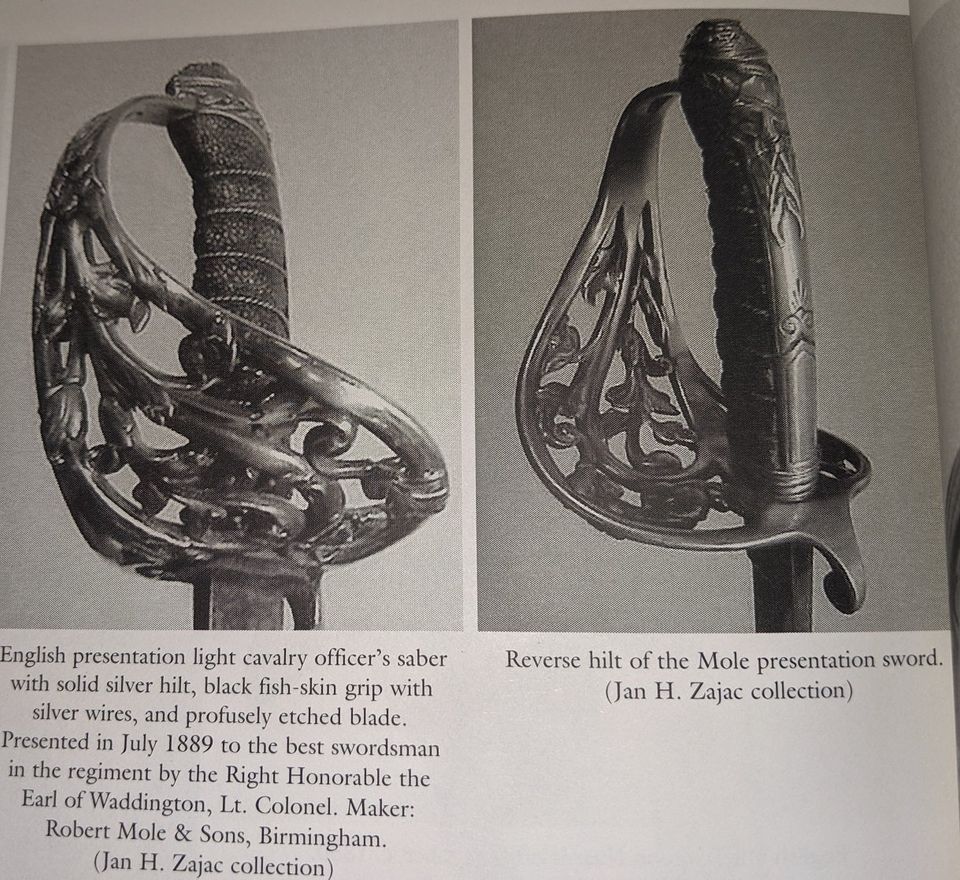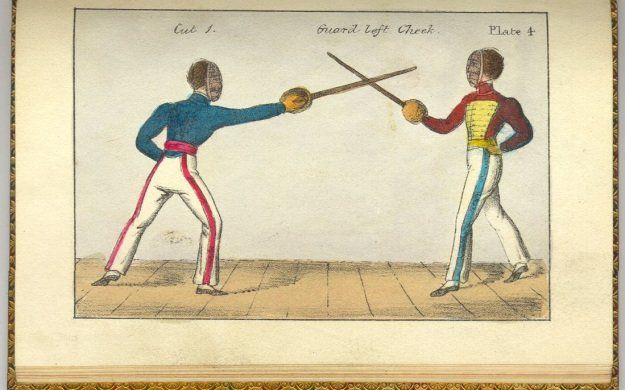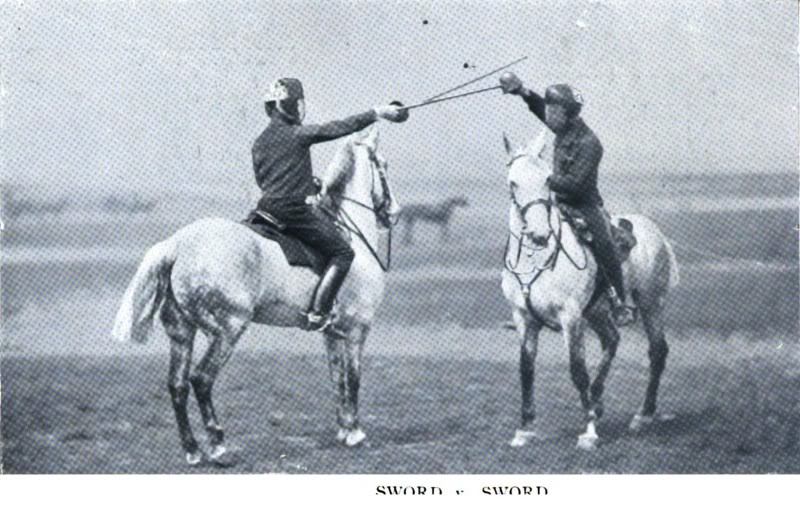'Best Swordsman in the Regiment' Contests and PrizesBy Matt Easton
'Best Swordsman in the Regiment' Contests and Prizes
By Matt Easton
Prize swords come in many different forms and the awarding of swords as prizes for specific achievements is a tradition that has its roots an antiquity. The giving of a sword was a potent symbol that carried enormous implications of duty and status in earlier civilisations and it is still occasionally done today. For example, each year the Royal Military Academy Sandhurst awards a Sword of Honour to the best performing officer cadet and the MacRobert Sword to the best performing Reserve officer cadet.
Occasionally when studying and collecting British Army antiques we come across a sword or other object, such as a medal, cup or trophy, which carries the dedication of 'Best Swordsman in the Regiment', or 'Best Swordsman in the Troop'. These were awarded at different levels, most often by regiments, including local volunteer yeomanry, right up to army level, awarded by the Commander in Chief.
We also find similar dedications for 'Best Marksman' and other awards, but here we will focus on the Swordsman subset. How were these 'Best Swordsmen' selected exactly?
Medal in the archives of Peter Cameron:
The 'Best Swordsman' dedication appears on many different types of object, particularly from around the middle of the 19th century onward. As a collector of swords, it is the dedicated swords which have probably caught my eye most often, although as a fencing instructor for the last 20 years, I have sometimes pondered how these various prizes were won.
Such 'Best Swordsman' presentation swords are sometimes completely standard troopers' swords with engraved or etched dedication added on and often they are officers' versions (even when presented to private soldiers). Occasionally these swords mix features of both trooper and officer swords and sometimes they are a completely custom-made special design. These latter sometimes have silver hilts or other valuable elements and the guards are sometimes in unique styles, as shown in the example below.
In my own collection are a few swords which, while not having any dedication on them, I have wondered if they were presentation swords for something like the 'Best Swordsman', due to peculiarities of their design, being neither regulation troopers' swords, nor officers' swords.
It is possible that occasionally such unmarked swords were presented to the Best Swordsman along with another object which had the dedication on, such as a tankard or plaque - in my collection I have a pair of custom-made late-19th century fencing/practice sabres which by chance came with a separate plaque, stating that they were for a school singlestick champion. The plaque is shown below.
I have also seen Indian clubs with similar separate dedications on plaques, that, had the plaque or medal become separated from the Indian clubs, we would never have known were associated now.
Having seen various dedicated presentation swords of this type myself over the years (I own a Best Marksman of the Bengal Cavalry & Artillery prize sword myself, presented by Lord Napier of Magdala), I started researching, to find how this particular 'Best Swordsman' award and title was arrived at.
I found that a number of publications from the 1860s and 1870s precisely detail the process.
There are many interesting things to note in these rules, which I have transcribed below.
Some points that I consider of particular note include:
- Entry in the contests was very exacting and contestants had to be able to prove their (foil) fencing ability, perform the attack and defence section of the sword (sabre) exercise on foot completely, as well as pass a riding test before they were even allowed to compete. If they did not pass any of these qualifying criteria, then they could not enter the main contest.
- The competition in cavalry regiments was conducted with protective clothing including masks and gloves, and single sticks (or blunt lances) on horseback. It was a free-moving mounted fencing contest, where valid hits on an opponent were counted and scores collated.
- Precise details are given of the rules used in these contests, such as how to treat double-hits and chalking of singlestick blades to indicate valid scoring hits. Hitting the horse was strictly disallowed.
- The no-hits-below-the-waist rule which is still used in modern FIE/Olympic sabre fencing probably has its roots in these contests, where the aim was to prevent injury to the horses. In Britain at this time the legs were usually a valid target in sabre fencing on foot and therefore the fact that attacks below the waist were not allowed in these contests had to be explicitly stated for a British military sabre fencing audience.
- Financial reward from the government from 1865 onward, was diverted in cavalry regiments from marksmanship awards to swordsmanship awards, with the pay prize for marksmanship becoming lower than for swordsmanship. This is interesting to note, at a time when arguably marksmanship was becoming more important and effective for cavalry.
- There is no mentioned of a prize sword being awarded to the champion - but from surviving antique examples and newspaper reports, we know that a prize of some sort was very often given at the discretion of the regiment or organisers.
The Rules
PRIZES FOR SWORD PROFICIENCY IN THE CAVALRY REGIMENTS
The subjoined document has been promulgated in a General Order from the Horse Guards, with the view of establishing prizes for proficiency in the use of the sword and lance in the Cavalry Regiments, and laying down the regulations for the guidance of officers in selecting the successful competitors:-
“The Secretary of State for War, having, on the recommendation of the Field-Marshal Commanding-in-Chief, approved of the sum hitherto allowed as good shooting pay being re-distributed, so as to admit the soldiers of Regiments of Cavalry in the ration of 6 per cent, wearing badges and receiving pecuniary rewards for proved skill in the use of the sword and lance, their peculiar weapon, the following regulations are to be observed in defining, classifying, and tabulating the degrees of skill in the use of the sword and lance, which, combined with horsemanship, will give a title to the prescribed prizes. The paid marksmen in Regiments carrying carbines are in future limited to 4 per cent.
“1st Prize.— A badge of cross swords and crown, worked in gold, entitling the wearer to additional pay at the rate of 2d. per day [2 pennies], to the best swordsman of each Regiment, in which all the troops have competed during the year.
“2nd Prize.— A badge of crossed swords, worked in gold, and entitling the wearer to additional pay at the rate of 1d. per day [1 penny] to the best swordsman of each troop in which at least 30 men shall be qualified to compete.
“3rd Prize.— A badge of crossed swords, worked in worsted, and entitling the wearer to additional pay at the rate of 1d. per day [1 penny], to the next best swordsman in each troop in the proportion of six per cent., or one man for every 16 competing.
The second best swordsman in the troop which furnishes the best swordsman the Regiment will, in that case, become the best swordsman in that troop, and the next best (according to their marks) be the men entitled to prizes as swordsmen in the prescribed proportion. The badges are to be worn on the left arm, so as to admit of being seen above the gauntlet; and if the same man has badges both for swordsmanship and good shooting, they are to be placed side by side so as to be equally visible from the front. The ‘best swordsman of the Regiment’ and the ‘best swordsman of the troop’ are to be allowed the rewards as such in addition to that attaching to the third prize, making the extra pay accompanying each prize respectively 3d., 2d., and 1d. daily.
Fencing is the groundwork of all attack and defence ; only those men, therefore, who are proficient therein after a complete course of instruction, who, in addition, are first-class horsemen, who can perform the sword exercise perfectly, both mounted and dismounted, who can go through the lessons for attack and defence, as laid down the Cavalry Sword Exercise book, pages 25 and 26, and the post practice, with leaping bar, in the riding school and open manège, are to contend for these prizes.
The competition is to be conducted as follows:—Previously to the Spring inspection a Board is to be assembled, consisting of the Major, the Senior Captain present, and the Adjutant, who will see in succession the men of each troop eligible to compete. 1st. Go through the fencing lesson under the Instructor. 2nd. Perform the sword exercise, with attack and defence on foot, under the Serjeant-Major. 3rd. Go through the double ride, with heads and posts and leaping bar, in the school, under the Riding Master, and the sword exercise, and attack and defence on horseback. Those who not pass these tests to the satisfaction of the board will be excluded from the competition for prizes for good swordsmanship, and their names are to be once entered in the proper column of the troop return, page 10, with the cause of rejection - such as ‘failed in posts,’ ‘failed in fencing,’ &c. As this return should account for every effective non-commissioned officer and man belonging to the troop, the names of all not qualified to compete, and the reasons why, such as ‘in hospital,’ ‘rough rider,’ ‘fencing instructor,’ ‘mess waiter,’ ‘batman,’ ‘second-class horseman,’ ‘recruit not dismissed,’&c., are also to be shown in the adjoining column. The names of those who pass satisfactorily the preliminary examination as above are then to be entered at page 2 of the troop return, with their Regimental and combatant numbers; and the men are to contend, mounted, with sticks and masks in the following manner: He who makes the most marks being recorded as the ‘best swordsman of the troop,’ and the proper number of those next in order of merit being noted as ‘swordsmen.’
The competitors are to draw lots as to who are to contend together, in the first instance each couple forming up at opposite ends of the riding school or manège, and attacking at any place they like. To prevent the unnecessary repetition of names, the combatant number each man’s opponent in the several assaults is to be entered in the same line as his own in the column assigned for that purpose in the return. Those who gain the most marks in the first assault will again draw lots, and compete in the next, and so on until the proper proportion of best swordsmen in each troop, according to the number competing, are shown. If, when the marks come to be added together, any two men are found to have ‘tied ’ for a Regimental or troop prize, they are to compete again, their performances in the preceding assault being marked through and a fresh entry made in the return, initialled the President of the Board, in the manner shown at page 6.
Decided points and cuts are to count equally. The point and side of the stick corresponding with the edge of the sword, and point of the lance foil, are to be chalked, and any cut or thrust not delivered with the edge or point of the weapon is not to count. If the opponents point or cut together, such points or cuts are not to count; and if this is repeated, it will be for the Board to judge which man made the best assault in each case, and score the marks in his favour accordingly. Any man wilfully striking his opponent’s horse is to forfeit one mark. If any man is thrown from his horse his opponent is to score all, or the remaining points. No cut or point is to be delivered below the waist-belt, or to count as mark.
There are to be five separate rounds or attacks in each assault, and the marks scored in each attack or round are to be entered in ink against each man’s name at the time of competition and in presence of the board. After all the troops have competed, their performances are to be transcribed from the troop returns into a general Regimental return—page 6—and a board, consisting of the Commanding Officer and two next senior officers, will see the best swordsman of each compete together in the same manner for the Regimental prize, and have their performances also entered therein.
The following prizes for Lancer Regiments are to be competed for under the same restrictions as those for swordsmen, after the prescribed preliminary examinations, with the lance exercise on horseback in addition, viz.: - 1st. A badge of cross lances and crown worked in gold, entitling the wearer to additional pay at the rate of 2d. per day [2 pennies] to the best Lancer in the Regiment in which all the troops shall have competed during the year. 2nd. A badge of cross lances in gold, entitling the wearer to additional pay at the rate of 1d. per day [1 penny] to the best lancer in each troop in which at least thirty men shall be qualified to compete. 3rd. A badge of cross lances in worsted, and entitling the wearer to additional pay at the rate of 1d. per day [1 penny] to the next best Lancers in each troop in the proportion of four per cent., or 1 to every 25 men of the number competing. 4th. A badge of cross swords in worsted, and entitling the wearer to additional pay at the rate of 1d. per day [1 penny] to the best swordsman in each troop, in the proportion of two per cent, of the numbers competing. If a man has badges both for sword exercise and lance practice, they are to be worn side by side, as before directed.
The lance being only a weapon of offence, it should be opposed at practice to the lance and to the stick and basket; for this purpose lots should be drawn, and the men compete under restrictions laid down for swordsmen.
The returns of swordsmanship and lance exercise are to be submitted at the spring inspection to the Inspector-General, or Cavalry Brigadier, who will see the men qualified to contend for prizes go through the above drills, and compete together but without disturbing the awards of the boards. The Regimental return is then to be confirmed and forwarded by him, in duplicate, to the Adjutant-General, with a view to authority being given by the War Office for the men entitled to prizes receiving the additional pay, to be held for 12 months from the 1st May. The troop returns are to be preserved until the next year’s competition shall have been gone through, when they may be destroyed under authority from the Inspector-General of Cavalry.
In the event of the best swordsman or lancer of a Regiment or troop becoming non-effective, his badge and the accompanying pay will lapse, but vacancies among the paid ‘swordsmen’ are to be filled by the next best in succession, as shown by the number of marks credited at the annual competition. Commanding Officers are to be held responsible that every recruit, before being dismissed, goes through the preliminary drill that entitles a man to compete, and that every man in the Regiment again goes through these drills, including loose play in the school, mounted with sticks daring the winter months.
Rough riders and fencing instructors are not to compete for prizes, as they receive extra pay for teaching.
In order that the sum now allowed prize pay for good shooting may not be exceeded, the prizes are to be strictly limited to the following numbers, viz.:- For Regiments at home on an establishment of 50 serjeants, 9 trumpeters, 496 rank and file—for sword and lance, 1 Regimental prize, 8 troop prizes, 27 swordsmen; for musketry, 19 marksmen. For Regiments in India, on an establishment of 54 serjeants, 12 trumpeters, 519 rank and file—for sword and lance, 1 Regimental prize, 9 troop prizes, 28 swordsmen; for musketry, 19 marksmen.
The competition for prizes for the present year is to take place during the summer, and the returns to be sent in after the autumn inspection, when the rewards will be recommended to be made payable for six months from the 1st October next.
“By command of His Royal Highness the Field-Marshal Commanding-in-Chief,
“JAMES YORKE SCARLETT,
“Adjutant-General."













